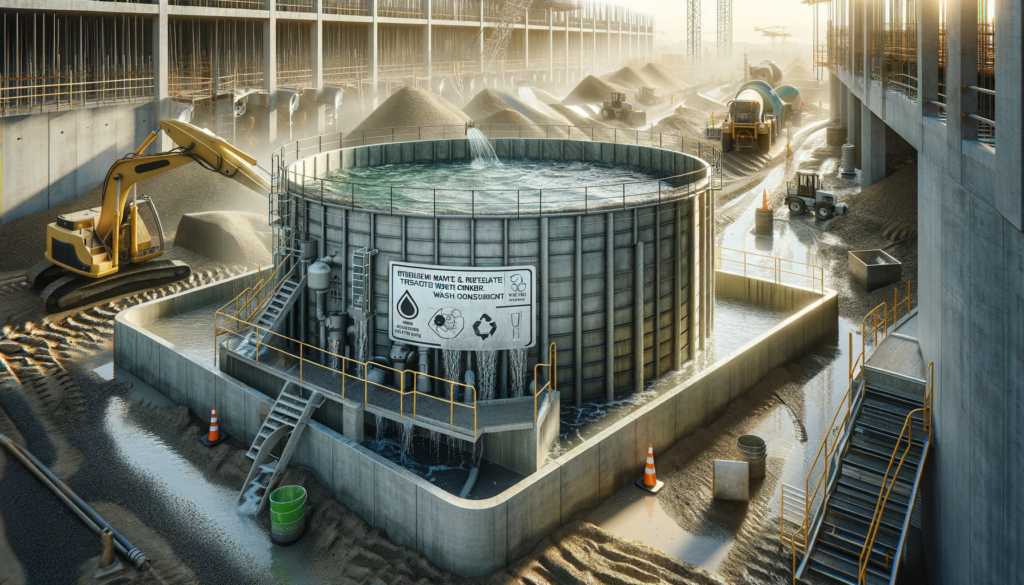In the dynamic and detail-oriented world of construction, effectively handling waste is a pivotal aspect that goes beyond mere site cleanliness or operational efficiency. It’s a commitment to preserving our environment. Here, the significance of a concrete washout system emerges prominently. Picture it as an unsung hero on a construction site, quietly but effectively managing a potential nuisance.
This article aims to illuminate the concept of concrete washouts, exploring their functionality and their vital role in contemporary construction methodologies. Grasping their importance allows contractors and industry professionals to make choices that are not only savvy in terms of project management but are also eco-conscious.
This information is invaluable whether you’re a veteran in the construction field or just beginning to explore its complexities. Delving into the world of concrete washouts promises to enrich your professional approach, aligning your projects with both efficiency and ecological stewardship.

What is a Concrete Washout?
In the world of construction, the concrete washout plays an indispensable role, acting as a critical component either on a temporary basis or as a permanent fixture. Its fundamental purpose is to effectively capture and process water utilized in washing off concrete remnants from a variety of construction equipment such as mixers, trucks, pumps, and other machinery engaged in concrete-related tasks. This setup goes beyond mere convenience; it stands as a pivotal environmental protective measure. Through its proficient capture and processing capabilities, concrete washouts avert the escape of cementitious waste – typically characterized by high alkalinity and containing potentially harmful substances – from contaminating the natural surroundings.
Engineered to cope with the substantial burden of wastewater mixed with concrete particulates, these facilities usually comprise a robust, impermeable container or an especially prepared area that’s reinforced to block any leakage into the soil. As equipment used for concrete is cleansed, the resultant runoff, laden with concrete particles, sand, and aggregates, flows into this washout system. Within this containment, the heavier particles descend to the bottom, segregating from the water. Subsequently, the now relatively clearer water can be subjected to additional purification processes or disposed of in an environmentally sound manner.
The significance of concrete washouts in the construction sector is immense and multifaceted. They play a vital role not only in upholding environmental norms and adhering to diverse regulatory mandates but also in safeguarding construction sites from the risks associated with hazardous waste. An effectively managed concrete washout system mirrors a construction project’s dedication to eco-friendly and responsible building approaches. With environmental regulations growing ever more rigorous, the necessity and prominence of concrete washouts in construction undertakings are expected to escalate, further emphasizing their crucial role in the contemporary building and construction landscape.
Why Concrete Washouts Are Essential
Protecting the Environment: The water used in concrete washouts is often full of harmful metals and has elevated pH levels, thanks to calcium hydroxide. Such characteristics pose a real threat to the environment, risking contamination of both soil and water bodies.
Adhering to Legal Standards: In numerous areas, there are strict laws in place that mandate the secure containment and proper handling of concrete washout water. These regulations aim to curb any potential environmental harm.
Ensuring Safety at the Worksite: When managed correctly, concrete washouts help to avoid the creation of dangerous pools of wastewater. This not only keeps the worksite tidier but significantly safer for everyone involved.
Maintaining Equipment Quality: Regular washing of construction equipment in designated washouts is key to maintaining their condition. This practice extends the equipment’s lifespan and maintains its performance.
Saving on Costs: Efficient management of concrete washouts can lead to substantial cost savings. This comes from avoiding environmental penalties and reducing the frequency of equipment repairs and maintenance.

How Does a Concrete Washout Operate?
The functionality of a concrete washout system is rooted in its simple yet effective design. Generally, it includes a specifically designated area or a container, often in the form of a large bin. This area is meticulously lined and sealed to ensure that no leakage occurs. The key to its effectiveness lies in this containment, as it prevents any contaminated water from escaping into the surrounding environment.
Once concrete pouring activities are completed on a construction site, the subsequent task involves cleaning the equipment used. This includes mixers, trucks, pumps, and other tools that come into contact with concrete. The washout process generates water that is laden with suspended particles, such as cement, fine sand, and aggregates. These particles, although minute, pose a significant environmental hazard if not managed correctly.
In the washout container, the water and its suspended contents are allowed to settle. Over time, the heavier particles naturally sink to the bottom, separating from the water. This sedimentation process is crucial as it helps in isolating the solid waste from the liquid. The solid waste, now settled at the bottom, consists mainly of the concrete by-products, which can later be collected and disposed of or recycled in an environmentally responsible manner.
Meanwhile, the water that remains on top, though cleaner than before, may still carry harmful substances. Depending on the specific practices and regulations of the area, this water can be treated further to remove any remaining contaminants. The treated water can then be safely reused on-site, or it can be disposed of according to local environmental guidelines.
The effectiveness of a concrete washout system is not just in its ability to contain and separate waste but also in its role as a critical component of sustainable construction practices. By preventing the runoff of potentially hazardous materials into the soil and water systems, these washouts play an essential part in protecting the environment and maintaining ecological balance.
Creating an Effective Concrete Washout Plan
To develop a successful concrete washout plan, there are several essential steps that need to be followed, ensuring that the system is both effective and environmentally compliant. The initial and a crucial step is to engage with local authorities. This collaboration is vital for gaining a clear understanding of the specific regulations and necessary permits for establishing a concrete washout. Such due diligence is key in adhering to regional standards and avoiding any legal issues.
Selecting the right location for the washout is another important consideration. It is crucial to choose a site that is safely removed from natural waterways and storm drains, thereby mitigating the risk of environmental contamination. Equally significant is the construction and design of the washout. It needs to be built with materials that prevent any leakage and designed in a way that corresponds with the scope of the project and the anticipated amount of washout water.
Ongoing maintenance plays a pivotal role in the operation of the washout. It involves regular checks to ensure that the washout is emptied and the accumulated slurry is properly treated. Preventing the slurry from drying is vital, as dry slurry can lead to airborne dust, which is a hazard to both health and the environment.
Finally, the management of the collected water is a key aspect. Options include treating the water on-site or transporting it to a specialized treatment facility. Innovations in this field have led to systems that enable the recycling of water, an approach that significantly cuts down on waste and supports resource preservation. Implementing such a well-rounded strategy in managing a concrete washout system is not only beneficial for the environment but also bolsters the efficiency and sustainability of construction operations.
Conclusion
Concrete washouts play a pivotal role in sustainable construction practices. They not only comply with legal requirements but also contribute significantly to environmental protection and site safety. Proper planning, implementation, and maintenance of concrete washouts are essential for any construction project involving concrete work.